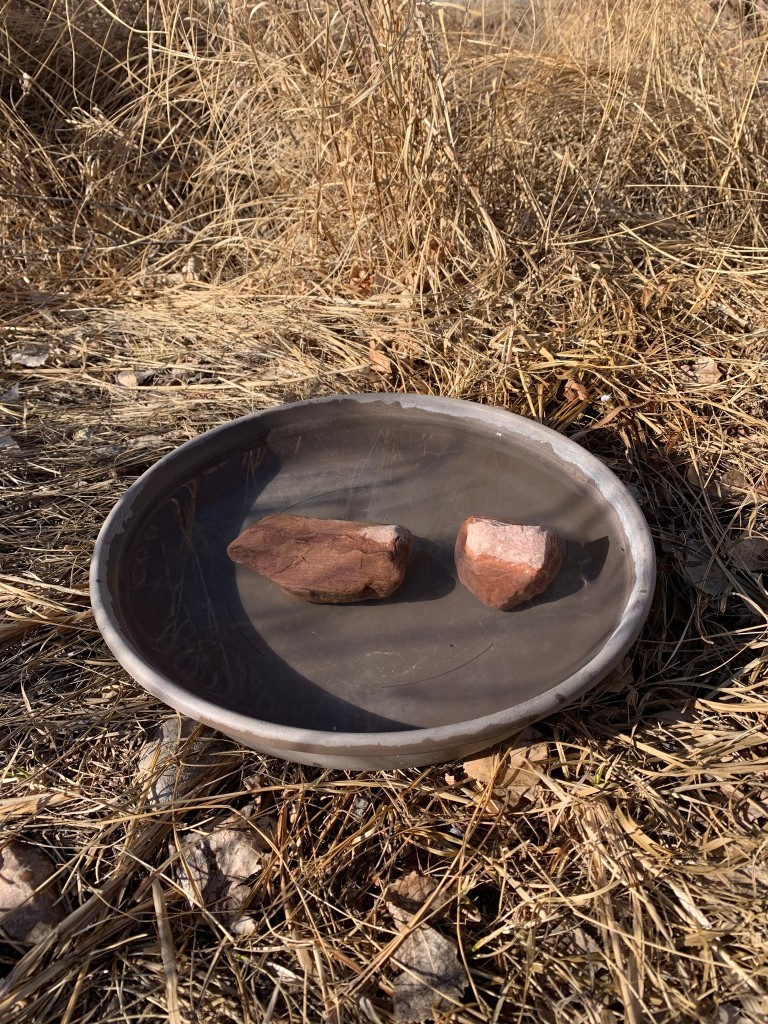Lincoln and the Cherry Creek Pollinator Habitat have received over 20 inches of snow so far in January. This moisture is good news and Nebraska is no longer in the ‘exceptional drought’ range.
Mary Jane Frogge

This was a dry year in southeast Nebraska. Watering plants and keeping the water features full was a priority this year in the Cherry Creek Habitat.

Looking at the data, we are on target to have more moisture that 2022. The University of Nebraska at Lincoln, Weather and Climate keeps monthly and annual precipitation totals (in inches) since 1887.
https://lincolnweather.unl.edu/data/monthly-precipitation.asp
Insect observations seem down this year. Saw very few Monarch butterflies and caterpillars. I observed this year:
leaf cutter bees (Megachile species)
bumble bees (Bombus species)
black swallowtail butterflies (Papilio polyxenes asterius)
painted lady butterflies (Vanessa cardui)
Chinese mantis (Tenodera sinensis)
Plants that bloomed and did well in the Cherry Creek Habitat this year include:
common milkweed (Asclepias syriaca)
butterfly milkweed (Asclepias tuberosa)
cup plant (Silphium perfoliatum)
partridge pea (Chamaecrista fasciculata)
sawtooth sunflower (Helianthus grosseserratus)
hoary vervain (Verbena stricta)
wild bergamot (Monarda fistulosa
tall thistle (Cirsium altissimum)
rosinweed (Silphium integrifolium)
chicory (Cichorium intybus)
brown-eyed Susan (Rudbeckia triloba)
pitcher’s sage (Salvia azurea)
Joe-pye weed (Eutrochium maculatum)
I am looking forward to a peaceful, restful winter and anticipating the first blooms of next year. What will 2024 bring?
Best holiday wishes, Mary Jane Frogge
Happy Winter Solstice from the Cherry Creek Pollinator Habitat!

“If Winter comes, can Spring be far behind?” —Percy Bysshe Shelley
“In seed time learn, in harvest teach, in winter enjoy.” —William Blake
“Winter is not a season, it’s a celebration.” —Anamika Mishra
“What good is the warmth of summer, without the cold of winter to give it sweetness?” —John Steinbeck
“Winter is a season of recovery and preparation.” —Paul Theroux
“Every winter has its spring.” —H. Tuttle
MJ Frogge
The Cherry Creek Pollinator Habitat has received much needed rain. It is raining right now! Plants have grown well and the habitat has greened up. Common milkweed, Joe-Pye weed, hoary vervain, bee balm, tall thistle, common yarrow, aster, penstemon, purple coneflower, goldenrod and cup plant are found in the in the Cherry Creek Pollinator Habitat. Master Gardener volunteers helped cut back dead plants, weed trees and spread mulch earlier this month. I added new blocks to the solitary bee house. We should be seeing leaf cutter bees soon. Spring is here.
MJ Frogge



The Cherry Creek Pollinator Habitat received much needed rain on Friday. Today, we woke up to a bit of snow. This tends to be our typical March weather in Nebraska.
MJ Frogge
February has been very dry with up and down temperatures. With the warm, dry weather I have received many calls asking, “Should I be watering the lawn and landscape plants?” The answer is yes, it is a good idea to water, if the ground is not frozen.
Wildlife will also benefit from adding water to the landscape and habitat. Keep bird baths and water features filled with clean water. A heated pet dish would be helpful when the temperature dips. Place a rock in these water features to provide a shallow perch for honey bees and birds. Honey bees will visit these water features when the temperature is above 45 degrees F.
MJ Frogge


Spring is here and we are enjoying the roller coaster of temperatures. Warm & sunny one day, cloudy & cold the next. That is spring in Nebraska. Due to COVID-19 we have a new normal to our life. Nebraska Extension staff are working remotely and the office is closed. I am disappointed I can not be in the Cherry Creek Pollinator Habitat, it is a special place. I like to watch the plants emerge and the start of bee activity. We can watch the Live Habitat Web Cam, so that does help me keep an eye on what is going on. You can watch too by clicking the link above.
I hope everyone is spending time in their home pollinator habitat. I have been. It is nice to spend lunch time outside seeing what is blooming and plotting my next project. Now is a good time to make a list of spring blooming plants you need to add to your habitat. Consider spring blooming bulbs like scilla, crocus, snowdrops, striped squill and glory-of-the-snow. Spring blooming trees include redbud, plums and cherries. Perennials that bloom in the spring are Dutchman’s breeches, spring beauty and pasqueflower.
Get outside!
MJ Frogge
More snow is expected for today, but we are ready. The new shed is done and looks great. Bird feeders are up and filled for the birds that visit our pollinator habitat. The no dumping snow sign is posted. Happy Thanksgiving!
MJ Frogge
Snow came to the Cherry Creek Pollinator Habitat overnight. It is a reminder that seasons change and winter is on its way. The trees are getting their fall color and the native grasses are beautiful with their tall seed head plumes. Milkweed pods are popping open and releasing their seeds and silky fluff. Nebraska is gorgeous in the fall.
MJ Frogge
Yesterday, March 20, was the Spring Equinox. Spring is here and we are so grateful. Nebraska has endured record snow fall and flooding, so we are happy to have sunny spring weather.
Now is a good time to think about what plants you could add to your pollinator habitat. The Nebraska Pollinator Habitat Certification program has an excellent list of spring, summer and fall blooming plants that are native to Nebraska. Look over the impressive plant list and also consider certifying your pollinator habitat. Learn more at this link: https://entomology.unl.edu/pollinator-habitat-certification
MJ Frogge